3 - Australia
Summary
In 1901, six previously independent Australian colonies, Victoria, New South Wales, Queensland, South Australia, Western Australia and Tasmania federated to form the Commonwealth of Australia. One of the catalysts was the need for national defence as distinct from each colony providing for its own security. Strategic and technological developments meant that a national, coordinated approach to defending Australia was needed to counter rising European Imperialism and Asian nationalism. Federation had long been a desired outcome in British Imperial policy. Even though the six colonies shared a continent, they were, in effect, separate nations with their own defence forces, customs and border checks, laws and even differing local currency and railway gauges. This diversity was to greatly impact on their ability to work together for the ‘national good’ and, until Federation was achieved, it certainly hampered attempts to develop national defence.
The Australian colonies had all achieved self-government through a similar process during the second half of the nineteenth century. As noted by Lord Grey, a requirement was that each colony must develop a scheme of defence against external attack. This could be achieved either by raising citizen forces within the colony, paying for an Imperial garrison, hosting ships of the Royal Navy's Australia Station, or a combination of all three. Each colony also had the secondary task of maintaining law and order. In the absence of organized and effective police forces, this latter task traditionally fell upon the military.
Each of the Australian colonies had a British garrison of varying size and type until 1870; occasionally, they also played host to ships of the Royal Navy. Despite this Imperial presence, the number of redcoats was far too small to mount an effective defence of each colony from external attack while at the same time ensuring internal stability. Colonial governments, therefore, relied on raising units of local citizens acting in a voluntary capacity, to provide a measure of defence. To understand this important role, one needs an overview of colonial defence in Australia, how it evolved over time, and its links to the wider Imperial defence.
- Type
- Chapter
- Information
- Citizen Soldiers and the British Empire, 1837–1902 , pp. 57 - 78Publisher: Pickering & ChattoFirst published in: 2014



